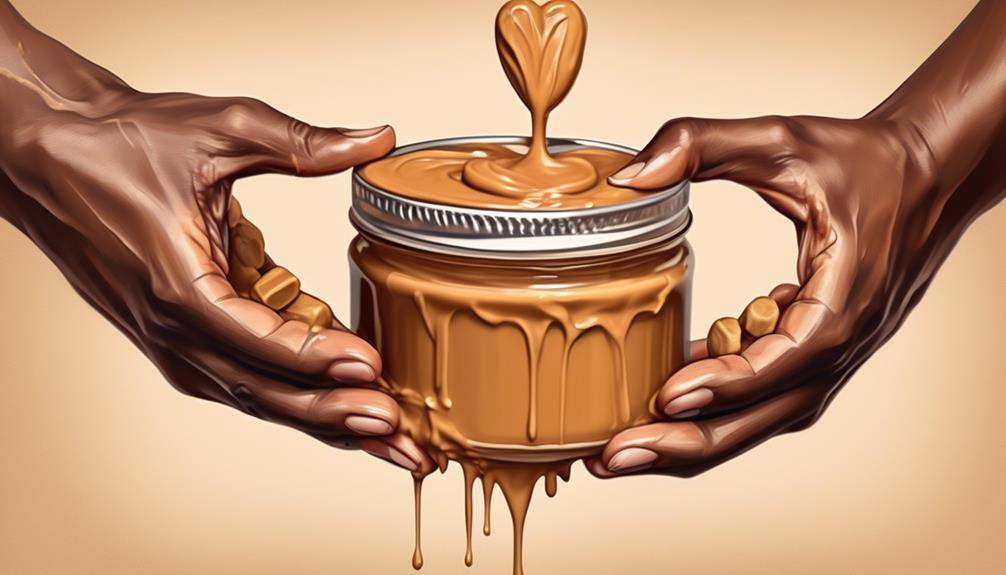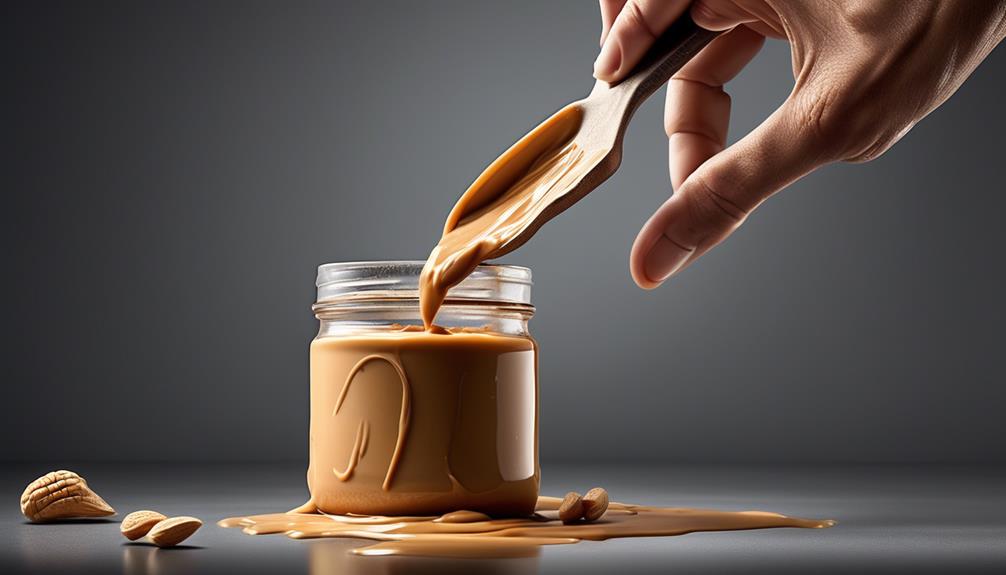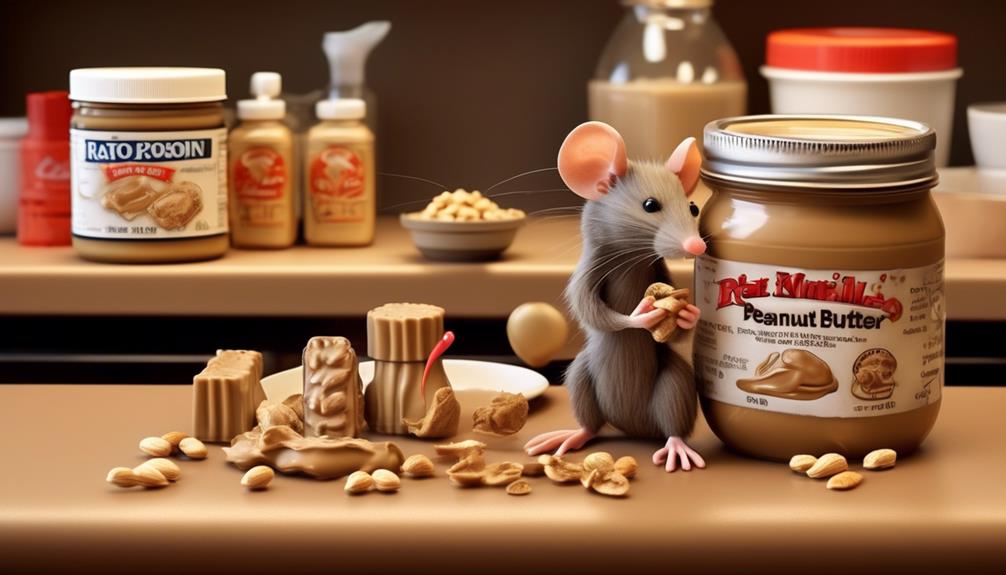We have all heard the phrase ‘peanut butter to my jelly’ used in different situations, and it might be tempting to brush it off as a cliché. Nevertheless, there is a deeper meaning behind this expression. It carries a significance that many of us can relate to on a personal level, and grasping its importance can provide insight into the intricacies of human connection and relationships.
But what exactly does it signify, and why do people use it to describe their bond with someone else? Join us as we unravel the layers of meaning behind this seemingly simple yet profound expression.
Key Takeaways
- The phrase 'Peanut Butter to My Jelly' originated in American pop culture during the 1990s and represents a close and complementary relationship between two people.
- It is inspired by the tradition of making peanut butter and jelly sandwiches, symbolizing perfect pairing and complementing each other.
- The phrase has permeated music, television, and literature, reinforcing its significance as a representation of profound connections.
- Personal interpretations of the phrase vary based on individual experiences and cultural backgrounds, contributing to the richness of discussions and understanding.
The Origins of the Phrase
The phrase 'Peanut butter to my jelly' originated in American pop culture during the 1990s, becoming a popular expression to describe a close and complementary relationship between two people. It's like the perfect pairing of peanut butter and jelly, where one just wouldn't be as satisfying without the other.
The origins of this endearing phrase can be traced back to the timeless tradition of making peanut butter and jelly sandwiches. As kids, we all remember the simple joy of spreading creamy peanut butter on one slice of bread and sweet, sticky jelly on the other, then bringing them together to create a delectable treat.
This act of combining these two distinct yet harmonious flavors mirrors the essence of a deep, interconnected bond between individuals. The phrase captures the idea that some things are just meant to be together, perfectly complementing each other in a way that brings out the best in both.
It's a reminder of the comfort and warmth found in the most cherished relationships, much like the familiar taste of a peanut butter and jelly sandwich.
Symbolism and Significance

As we explore the symbolism and significance of the phrase 'Peanut butter to my jelly', we uncover its deeper cultural and emotional connotations.
The pairing of peanut butter and jelly goes beyond being a classic flavor combination; it symbolizes stability and grounding (peanut butter) as well as sweetness and playfulness (jelly), creating a harmonious balance between practicality and joy.
This symbolism extends beyond food pairings and is evident in various aspects of life. From home decor to accessories, the concept of complementing elements is reflected in vinyl wall art decals, jewelry, and wedding ceremony signs, all conveying personal style, protection, and love.
In relationships and work environments, the phrase 'peanut butter to my jelly' signifies a strong connection and compatibility, reflecting mutual support, respect, and trust.
Its cultural significance extends globally, resonating as a simple and satisfying meal associated with cherished childhood memories. While regional differences and controversies may influence its interpretation, the phrase continues to hold profound emotional and cultural significance, representing the essence of a perfect match or complement in various contexts.
Cultural References in Media

Exploring cultural references in media reveals how the phrase 'peanut butter to my jelly' has permeated various forms of entertainment and communication. This phrase has made its way into popular culture through music, television, and literature, becoming a recognizable symbol of close relationships. Here's a glimpse of how it has been depicted in different forms of media:
| Media Form | Example | Description |
|---|---|---|
| Music | Song Lyrics | Numerous songs use the phrase to convey love and affection. |
| Television | Dialogue in Shows | Characters often use it to express the strength of their bond. |
| Literature | Book Titles and Quotes | Authors employ it to evoke themes of friendship and emotional ties. |
These instances showcase how the phrase has transcended its literal meaning to become a cultural touchstone, resonating with audiences across different mediums. Its widespread usage reinforces its significance as a representation of profound connections, adding depth and relatability to the media in which it appears.
Personal Interpretations

We all bring our own experiences and perspectives to the table, shaping how we interpret the phrase 'peanut butter to my jelly.'
Our personal connections and memories can influence the way we understand and relate to this common expression.
As we explore the various interpretations of this phrase, we may uncover the rich diversity of meanings that it holds for different individuals.
Individual Perspectives
In understanding the phrase 'Peanut Butter to My Jelly,' individual perspectives, shaped by personal experiences and cultural backgrounds, play a significant role in interpreting its meaning.
Our unique viewpoints and understandings, influenced by our cultural background, upbringing, education, and life experiences, lead to diverse interpretations of this phrase. These perspectives not only shape our understanding of the phrase itself but also influence how we perceive and interpret information, events, and interactions with others.
It's important to recognize and respect these individual perspectives to foster understanding, empathy, and cooperation among people with different viewpoints. Embracing the diversity of thoughts and approaches resulting from individual perspectives is essential for creating a harmonious and inclusive society.
Our personal interpretations contribute to the richness of discussions and the depth of understanding in our interactions with each other.
Unique Connections
Shaped by our unique perspectives and experiences, 'Unique Connections (Personal Interpretations)' involves uncovering individualized relationships and associations between elements, fostering diverse and imaginative understandings. It's about finding those unexpected links that resonate deeply with us on a personal level.
When we make these unique connections, we're tapping into our individual creativity and insight, allowing us to see things in a new light. It's like finding a secret pathway that leads to a hidden treasure of understanding.
These connections are what make our interpretations meaningful and deeply personal. They reflect the richness and diversity of our own experiences, showing us that there are countless ways to view and understand the world.
Embracing these unique connections opens the door to a world of unconventional but deeply meaningful insights.
Relationship Dynamics

Let's talk about the dynamics that shape our relationships.
We all seek mutual support and harmony in our connections with others.
Understanding interdependence and complementary roles play a crucial part in fostering meaningful and fulfilling relationships.
Mutual Support and Harmony
Fostering mutual support and harmony in relationships involves maintaining a delicate balance of giving and receiving support to create a strong and fulfilling bond between individuals.
- Both partners need to feel heard and understood, creating an environment where both can openly express their needs and feelings.
- Mutual support means being there for each other during both joyous and challenging times, offering comfort, encouragement, and reassurance.
- By nurturing mutual support and harmony, a sense of unity and understanding is cultivated, allowing the relationship to thrive and grow stronger.
These dynamics require a balance of giving and receiving support to maintain a healthy and harmonious relationship.
It's about being each other's rock, holding space for one another, and fostering an environment where both individuals can flourish and feel truly connected.
Interdependence and Connection
Interdependence and Connection in relationships thrive on the mutual reliance and connection between individuals or entities. It's about recognizing that our lives are intertwined, and our well-being is linked. This dynamic extends beyond romantic relationships to encompass friendships, family ties, and professional collaborations.
It's the understanding that our success and fulfillment are often dependent on the support and cooperation we receive from others. Embracing interdependence fosters a deep sense of connection and understanding. It's about being attuned to each other's needs and offering unwavering support.
Whether in personal or professional settings, acknowledging our interdependence promotes empathy, collaboration, and collective growth. It's the cornerstone of healthy, sustainable relationships, nurturing an environment where everyone can flourish together.
Complementary Roles in Relationships
In healthy relationships, partners often assume complementary roles that harmonize their strengths and weaknesses, fostering a balanced and supportive dynamic.
- Balanced Interaction: Complementary roles lead to a more cohesive and supportive dynamic, where each partner's traits and abilities complement those of the other. This balance creates a sense of teamwork and unity within the relationship, allowing each partner to feel valued and understood.
- Supportive Growth: Embracing complementary roles enables partners to effectively support each other's growth and well-being. This support fosters a more fulfilling and resilient relationship, as each individual feels empowered to navigate challenges and celebrate successes together.
- Enhanced Connection: By embracing complementary roles, partners can deepen their connection and understanding of each other, creating a more intimate and harmonious bond.
Embracing the Connection

Embracing the Connection emphasizes the importance of trustworthy relationships in the workplace and the mutual respect necessary for healthy collaboration and communication, fostering a supportive and productive professional environment. It's about finding that person who understands your professional journey, celebrates your victories, and supports you through challenges. This concept encourages us to embrace laughter and lightheartedness, to build a positive work environment that prevents burnout and encourages creativity.
| Embracing the Connection | Benefits |
|---|---|
| Trustworthy Relationships | Fosters a sense of security and belonging |
| Work Best Friend | Offers support and feedback, reducing stress |
| Laughter in the Workplace | Creates a positive and joyful environment |
| Emotional Support | Encourages a healthy work-life balance |
When we embrace the connection, we create a safe space where we can be ourselves, share our ideas, and thrive in our professional endeavors. It's about finding that person who is the peanut butter to our jelly, the one who brings stability and joy to our work life. Embracing the connection is essential for our well-being and success in the workplace.
Frequently Asked Questions
What Is the Meaning of the Peanut Butter to My Jelly?
We understand the phrase 'peanut butter to my jelly' as a heartfelt expression of deep connection, often used to convey a strong bond or affectionate relationship between individuals.
It signifies a perfect complement or match, much like the classic pairing of peanut butter and jelly, representing a balance of stability and sweetness.
This phrase holds cultural significance, evoking nostalgic memories and comfort, and symbolizing the harmony and compatibility between two people.
What Is the Expression Like Peanut Butter and Jelly?
We absolutely adore the expression 'peanut butter and jelly'! It's like the ultimate dynamic duo, symbolizing an unbreakable bond. It's the perfect metaphor for a relationship that's inseparable, supportive, and brings out the best in each other.
Just like peanut butter and jelly create a delicious combination, this phrase captures the essence of unity and harmony in a deeply connected relationship. It's simply heartwarming!
What Does Peanut Butter and Jelly Mean Jealous?
We understand the curiosity around the phrase 'peanut butter to my jelly.' It's often used to express a strong connection or compatibility between two people.
When someone asks if it means 'jealous,' it's important to clarify that the phrase typically conveys love or affection, not jealousy.
In our experience, it's all about highlighting a deep emotional bond, like the classic pairing of peanut butter and jelly, which symbolizes comfort and unity.
What Is the Caption of Peanut Butter to My Jelly?
We've all used cute captions to express our affection for someone special. The caption 'peanut butter to my jelly' symbolizes a deep bond and a perfect match. It's a sweet and endearing way to convey a sense of completion and harmony in a relationship.
This phrase encapsulates the idea of two things that just belong together, creating a sense of unity and love. It's a delightful way to express a strong connection with someone dear.
Conclusion
Just as peanut butter and jelly come together to create a classic and beloved combination, the phrase 'peanut butter to my jelly' symbolizes a deep and meaningful connection between two individuals.
It represents the idea of finding a perfect match, a complementary partner, and a source of comfort and joy.
Embracing this metaphor allows us to appreciate the beauty of close relationships and the magic of finding someone who truly completes us.










